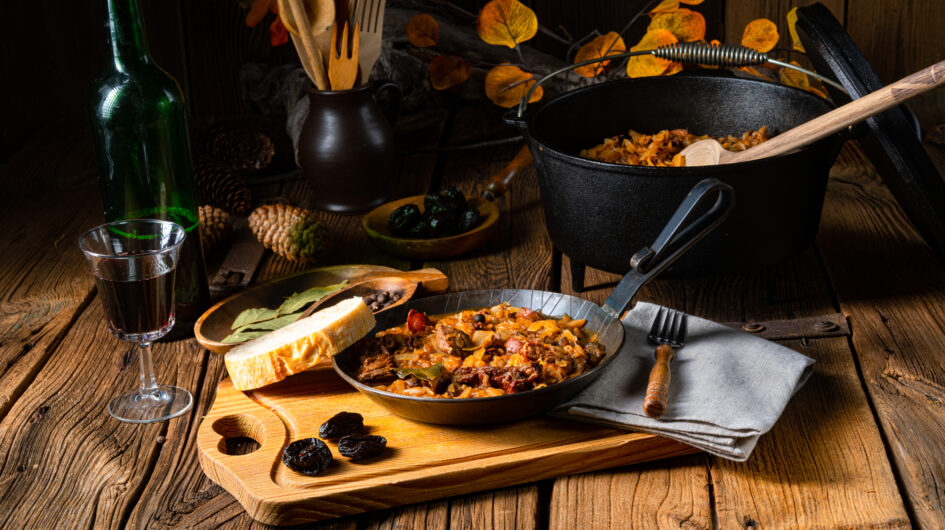If you ask a Pole which is the most Polish culinary tradition, I am quite sure the answer, given most often, will be bigos. Strangely enough, the perception of our cuisine (if any) outside our country would place some other staple country dishes (pierogi for example) before it. But for us, it is definitely bigos – the Polish traditional “hunter” stew based on a variety of meats cooked into a hearty vegetable mix of which cabbage (both fresh or soured/pickled or both) is the main ingredient.
The word comes from the old Polish term – “bigosowac” meaning cutting into small pieces. Our ancestors used that phrase more often in the context of what would they do to their enemies rather than with food, still, a number of “bigosiki” recipes can be found in the oldest Polish cookbooks (“Compendium ferculorum” – 1682). They were mostly cut meat mixes though and vegetables were used in them rather sparsely. Moder bigos is becoming lighter and less meaty and I have already cooked a purely vegetarian version of it (using meat-alternative products) on several occasions for my friends and customers. However, traditionally it is a balance of meat and cabbage which make it work.
The beauty of it is that once you have the main idea of what bigos is and learn some basic principles of its cooking you can’t really go wrong with it. It’s like Sunday roast or spaghetti bolognese – you need to be truly retarded to waste such a dish. We will present on these pages recipes of several variations of Bigos as well as reviews of quality products of that kind you can buy ready-made. Here let me just share with you some basic points which help avoid misfortune with Bigos:
Meat – It is really about variety and mixing flavours. We usually use at least two kinds of red meat one of which comes from diced smoked sausage and the other most likely is pre-cooked (roast or boiled) pork. You can add though any other kind of red meat and venison is quite popular nowadays. In the past, bigos was very often an outdoor cooking enterprise and would culminate hunting events hence the alias name – hunter’s stew. So in the end you would put in it what you had managed to kill – hare, squirrel, deer, bear, your uncle … 🙂 I don’t think though that modern farmed poultry should be used – it is too soft and delicate a meat but game birds can be combined with other flesh nicely. Now, and again – IT IS ALL ABOUT BALANCE. So depending on what you put in it, it has to be well pre-cooked and then added to the stew at the final stage so it is soft and tender enough. Bigos does though do a magic trick – once cooked and well balanced – it is then ready for storing. It means that it is not at its best straight after cooking. We strongly believe in Poland that it’s better when the flavours mix completely and the effect takes time. So, cooling, storing refrigeration and re-heating does not spoil the quality of the dish, au contraire mon frère. There is a climax point of course and you can’t repeat the reheating process forever but my personal experience is that a pot of bigos lasts up to a week and does not lose its quilty at least for 3-4 days.
Cabbage – Nowadays bigos takes its distinctive flavour mostly from sauerkraut. You can add fresh cabbage or you can even base the whole dish on it but you will miss that specific palate of savoury acidity which soured cabbage adds to it. There’s an article about sauerkraut in this blog so I won’t repeat the arguments for eating something which has “gone sour”. Using that ingredient as a base of bigos, makes it what we traditionally mean by it. Now the most common mistake, inexperienced cooks make with it is that the sauerkraut is … too sour. Some of the cheaper producers of it use vinegar to speed up the process and enhance acidity. In any case, though, I mean even if sauerkraut is perfectly balanced itself you definitely need to SOAK IT IN WATER for a period of time to lose the excess sour flavour. What is the excess … well I can’t tell you. You will have to find it yourself and people vary in preferences in this matter. Which makes it worse your dinners will also have a different opinion on this. So use your common sense. Keep soaking until the sauerkraut taste is palatable enough for you bearing in mind that it will have to give the whole acidity to the entire pot later in cooking. I usually soak it overnight but the process can be sped up by changing the water more frequently. Sauerkraut should be also pre-cooked in water with some basic herbs (bay leaf, allspice) prior to the main cooking but here it is mostly about softening it slightly and not overcooking.
And the rest – well as I said, you can’t really go wrong with it. Following recipes, in the beginning, is useful but then you have to find your own bigos method and flavour i.e. your own and true Polish Taste.

